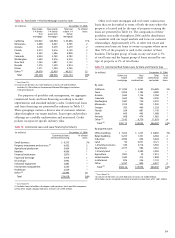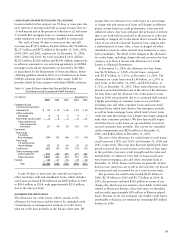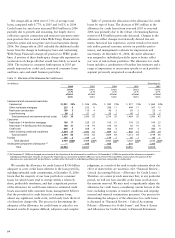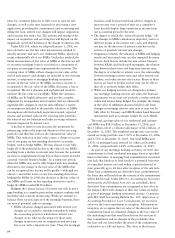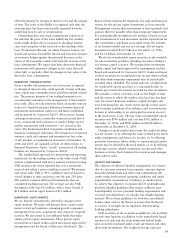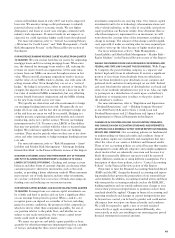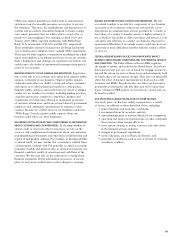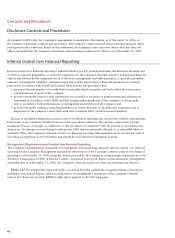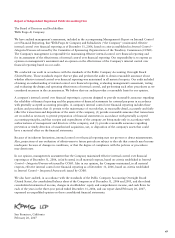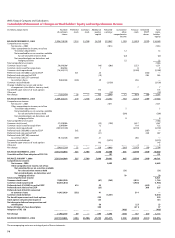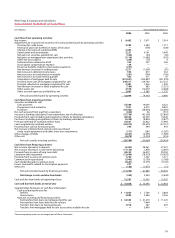Wells Fargo 2006 Annual Report Download - page 63
Download and view the complete annual report
Please find page 63 of the 2006 Wells Fargo annual report below. You can navigate through the pages in the report by either clicking on the pages listed below, or by using the keyword search tool below to find specific information within the annual report.
61
Risk Factors
An investment in the Company has risk. We discuss below
and elsewhere in this Report and in other documents we file
with the SEC various risk factors that could cause our finan-
cial results and condition to vary significantly from period
to period. We refer you to the Financial Review section and
Financial Statements and related Notes in this Report for
more information about credit, interest rate and market risks
and to the “Regulation and Supervision” section of our 2006
Form 10-K for more information about legislative and regu-
latory risks. Any factor described below or elsewhere in this
Report or in our 2006 Form 10-K could, by itself or together
with one or more other factors, have a material adverse effect
on our financial results and condition and on the value of an
investment in Wells Fargo. Refer to our quarterly reports on
Form 10-Q that we will file with the SEC in 2007 for material
changes to the discussion of risk factors.
In accordance with the Private Securities Litigation
Reform Act of 1995, we caution you that one or more of the
factors discussed below, in the Financial Review section of
this Report, in the Financial Statements and related Notes
included in this Report, in the 2006 Form 10-K, or in other
documents we file with the SEC from time to time could
cause us to fall short of expectations for our future financial
and business performance that we may express in forward-
looking statements. We make forward-looking statements
when we use words such as “believe,” “expect,” “antici-
pate,” “estimate,” “will,” “may,” “can” and similar expres-
sions. Do not unduly rely on forward-looking statements, as
actual results may differ significantly from expectations.
Forward-looking statements speak only as of the date made,
and we do not undertake to update them to reflect changes
or events that occur after that date.
In this Report we make forward-looking statements about:
• management’s belief that the provision for credit losses
for consumer loans, absent a significant credit event,
will closely track the level of related net charge-offs;
• the expected reduction of our net interest expense by
approximately $320 million over the next twenty years
from the extinguishment of trust preferred securities;
• our expectation that we will open 100 regional banking
stores in 2007;
• our belief regarding the loss content of our residential
real estate loans and auto loans;
• the adequacy of our allowance for credit losses;
• our anticipation that we will not incur additional credit
losses attributable to Hurricane Katrina;
• the expected impact of changes in interest rates on loan
demand, credit losses, mortgage origination volume, the
value of MSRs, and other items that may affect earnings;
• the expected time periods over which unrecognized
compensation expense relating to stock options and
restricted share rights will be recognized;
• the expected timing and impact of the adoption of new
accounting standards and policies;
• future credit losses and nonperforming assets, including
changes in the amount of nonaccrual loans due to portfolio
growth, portfolio seasoning, and other factors;
• the extent to which changes in the fair value of derivative
financial instruments will offset changes in the fair value
of derivative loan commitments;
• future short-term and long-term interest rate levels and
their impact on net interest margin, net income, liquidity
and capital;
• anticipated capital expenditures in 2007;
• expectations for unfunded credit and equity investment
commitments;
• the expected impact of pending and threatened legal
actions on our results of operations and stockholders’
equity;
• the anticipated use of proceeds from the issuance
of securities;
• how and when we intend to repurchase shares of our
common stock;
• the amount and timing of future contributions to the
Cash Balance Plan;
• the recovery of our investment in variable interest entities;
• future reclassification to earnings of deferred net gains
on derivatives; and
• the amount of additional consideration payable in
connection with certain acquisitions.
OUR ABILITY TO GROW REVENUE AND EARNINGS WILL SUFFER IF WE
ARE UNABLE TO CROSS-SELL MORE PRODUCTS TO CUSTOMERS.
Selling more products to our customers—or “cross-selling” —is
the foundation of our business model and key to our ability to
grow revenue and earnings. Many of our competitors also focus
on cross-selling, especially in retail banking and mortgage lend-
ing. This can put pressure on us to sell our products at lower
prices, reducing our net interest income and revenue from our
fee-based products. It could also affect our ability to keep exist-
ing customers. New technologies could require us to spend more
to modify or adapt our products to attract and retain customers.
Increasing our cross-sell ratio—or the average number of prod-
ucts sold to existing customers—may become more challenging,
and we might not attain our goal of selling an average of eight
products to each customer.
AN ECONOMIC SLOWDOWN COULD REDUCE DEMAND FOR OUR PRODUCTS
AND SERVICES AND LEAD TO LOWER REVENUE AND LOWER EARNINGS.
We earn revenue from interest and fees we charge on the loans
and other products and services we sell. When the economy slows,
the demand for those products and services can fall, reducing our
interest and fee income and our earnings. An economic downturn
can also hurt the ability of our borrowers to repay their loans,
causing us to incur higher credit losses. Several factors could cause
the economy to slow down or even recede, including higher energy
costs, higher interest rates, reduced consumer or corporate spend-
ing, a slowdown in housing, natural disasters, terrorist activities,
military conflicts, and the normal cyclical nature of the economy.


